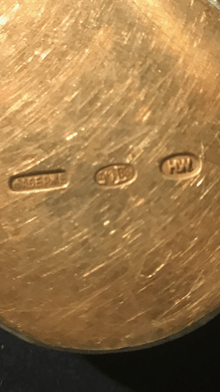Fauxbergé

Fauxbergé [1] is an ironic term coined to generally describe items that are faking a higher quality or status and in specific terms seem to relate to the House of Fabergé (French pronunciation: [fabɛʁʒe]) (Russian: Дом Фаберже) which is a jewellery firm founded in 1842 in St. Petersburg, Imperial Russia, by Gustav Fabergé. The term was first mentioned by auctioneer and Fabergé book author Dr. Geza von Habsburg in his article Fabergé in America.[2] Today the term is a part of the expertise vocabulary in the vast and popular field of Fabergé products. It is even used in a recent museum show only about Fauxbergé items.[3] The terms mainly refers to items that are exact copies or replicas of historical Fabergé products of the time period between 1842 and 1918. Fauxbergé jewelry started to show up on the market as soon as the Fabergé brand became a house hold name in the European aristocratic circles. After the second world war the trade of Fabergé products from communist Russia and other eastern block countries picked up and prices started to rise again. While an imperial easter egg auctioned in the 1930s for around 500 US Dollars it sold at auction for several million US Dollars after 1945. Direct copies and designs that look like Fabergé originals flooded the market. Fabergé did not entirely invent his own style but he himself copied historical pieces from European museum collections. It became a big business to erase marking stamps of historical or contemporary jewelry, silver and carved stones and place a false Fabergé stamp copy into the objects. Habsburg points out that an expert can see the difference between Carl Fabergé designed objects and fakes by simply looking at them.[4] The production of Fabergé objects around 1900 poured out a much vaster amount of pieces than the popular perception. the reason for this being that imperial Fabergé Egges are actually limited to 54 pieces, while general Fabergé objects and jewelry items could exist in high numbers. It is estimated that the Fabergé company produced over a half a million products between 1842 and 1917. With over 500 craftsmen and designers in their employment, Carl Fabergé produced over 200,000 objects between 1882 and 1917. In its time Fabergé had been the most recognized and most highly valued jewelry brand in the world, surpassing Cartier and others by far.[5][6] Today the big collections in Museums and private shows have Fauxbergé pieces in them and they in return are now considered curiosities. While the other famous jewelry brands are struggling to divide their market into originals and fakes the Fabergé non-brand of the second half of the 20th century enjoyed a collectors high of anything resembling Fabergé with the brand name attached to it or even without.[7] In comparison, Fauxcartier objects do exist but these copies of the well known jeweler Cartier are not sought after or shown in exhibitions on purpose.[8] Not all Fabergé items are protected by copyright law and especially collectors who own one of a kind creations are legally allowed to reproduce and sell such objects. Many museum stores offer replicas of their Fabergé objects form their collections. Carl Fabergé had may stores and shops and employed many freelance designers and jewelers. He had many so-called work masters who worked entirely independent from his business out of their own shops. These work masters kept producing their own objects with similar styles and these could have been stamped with false stamps in the succeeding years as well. Cartier and Tiffany's started to sell very similar frames and objects as Carl Fabergé and even bought from the same sources. Especially the stone sculptures which are never stamped or engraved can be mistaken for Fabergé originals. According to Habsburg a sure way to sort out fakes is that Carl Fabergé always used a maximum of two stamps and that most copies show more than two stamps.https://www.nytimes.com/1996/01/20/nyregion/about-new-york-imperial-gems-for-viewing-and-devouring.html Although Fauxbergé objects are frowned upon by experts they do enjoy a very high popularity and are often sold, collected and exhibited side by side with authentic Fabergé objects.https://www.washingtontimes.com/news/2011/aug/9/virginia-museum-fine-arts-displays-faberge-treasur/ [9] The reason for the popularity of the replicas and false objects is that today they fall in the category of art rather than jewelry.[10]
References
- ↑ "Verboticism: Fauxberge". www.verbotomy.com. Retrieved 2018-06-16.
- ↑ ISBN10 0500092397
- ↑ "All that glitters in Vegas is gold – Fabergé exhibit opens at Bellagio". Las Vegas Blogs. Retrieved 2018-06-16.
- ↑ "Avoiding `Faux-bergé` Pitfalls". Antiques Roadshow. Retrieved 2018-06-16.
- ↑ "types of items Faberge made | The Enchanted Manor". theenchantedmanor.com. Retrieved 2018-06-16.
- ↑ "Collecting Guide: 15 things you need to know about Fabergé | Christie's". Retrieved 2018-06-16.
- ↑ TrueFacet (2017-06-12). "How to Spot a Fake Cartier Ballon Bleu Watch: 5 Red Flags". Retrieved 2018-06-16.
- ↑ "Why You Shouldn't Buy Cartier Love Bracelet Replica". designersanddiamonds.com. Retrieved 2018-06-16.
- ↑ https://www.invaluable.com/blog/faberge-price-guide/
- ↑ "Fauxberge Revealed". Kasey Smith. Retrieved 2018-06-16.